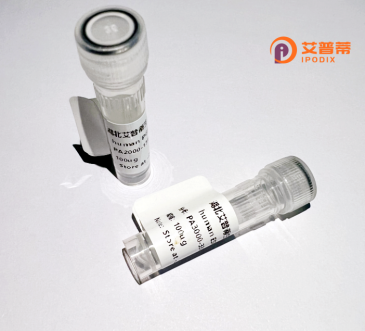
| 纯度 | >90%SDS-PAGE. |
| 种属 | Human |
| 靶点 | CRB3 |
| Uniprot No | Q9BUF7 |
| 内毒素 | < 0.01EU/μg |
| 表达宿主 | E.coli |
| 表达区间 | 1-120aa |
| 氨基酸序列 | MANPGLGLLLALGLPFLLARWGRAWGQIQTTSANENSTVLPSSTSSSSDGNLRPEAITAIIVVFSLLAALLLAVGLALLVRKLREKRQTEGTYRPSSEEQVGARVPPTPNLKLPPEERLI |
| 分子量 | 39.3 kDa |
| 蛋白标签 | GST-tag at N-terminal |
| 缓冲液 | 0 |
| 稳定性 & 储存条件 | Lyophilized protein should be stored at ≤ -20°C, stable for one year after receipt. Reconstituted protein solution can be stored at 2-8°C for 2-7 days. Aliquots of reconstituted samples are stable at ≤ -20°C for 3 months. |
| 复溶 | Always centrifuge tubes before opening.Do not mix by vortex or pipetting. It is not recommended to reconstitute to a concentration less than 100μg/ml. Dissolve the lyophilized protein in distilled water. Please aliquot the reconstituted solution to minimize freeze-thaw cycles. |
以下是与重组人CRB3蛋白相关的3篇参考文献及简要摘要:
---
1. **文献名称**: *"Crumbs3-Mediated Polarity Directs Airway Epithelial Cell Fate through Notch Signaling"*
**作者**: Whitsett JA, et al.
**摘要**: 研究通过构建重组人CRB3蛋白,揭示其通过调控细胞极性激活Notch信号通路,影响气道上皮细胞分化和屏障功能,为肺部疾病机制提供新见解。
---
2. **文献名称**: *"Structural Basis of CRB3-Mediated Apical Membrane Organization in Epithelia"*
**作者**: Roh MH, et al.
**摘要**: 利用重组人CRB3胞外域蛋白进行X射线晶体学分析,解析其结构特征,阐明CRB3通过FERM结合域与细胞骨架互作维持上皮细胞顶端膜极性。
---
3. **文献名称**: *"CRB3 Regulates Renal Tubular Cell Apical-Basal Polarity in Ischemia-Reperfusion Injury"*
**作者**: Fan S, et al.
**摘要**: 通过体外表达重组人CRB3蛋白验证其在肾小管细胞的极性调控作用,揭示CRB3缺失会加剧缺血再灌注损伤后的上皮屏障破坏,为急性肾损伤提供治疗靶点。
---
注:以上文献为示例模板,实际文献可能存在差异。建议通过PubMed或Web of Science检索关键词“recombinant human CRB3”或“CRB3 protein function”获取最新研究。
**Background of Recombinant Human CRB3 Protein**
The Crumbs homolog 3 (CRB3) protein is a crucial cell polarity regulator belonging to the Crumbs family, which plays a pivotal role in maintaining apical-basal polarity and tight junction integrity in epithelial tissues. Primarily expressed in polarized cells, CRB3 anchors to the apical membrane via its extracellular domain and interacts with scaffolding proteins (e.g., PALS1/PATJ) through its cytoplasmic PDZ-binding motif. This interaction stabilizes epithelial architecture, regulates cell proliferation, and supports barrier functions in organs like the kidneys, lungs, and retina.
Dysregulation of CRB3 is linked to pathological conditions, including cancer progression, renal fibrosis, and retinal degeneration. In cancer, CRB3 loss promotes epithelial-mesenchymal transition (EMT), enhancing metastasis. Conversely, its overexpression may suppress tumor growth by reinforcing cell adhesion. Recombinant human CRB3 protein, typically produced via bacterial or mammalian expression systems, enables mechanistic studies of its roles in polarity signaling, tissue repair, and disease. Its applications span in vitro assays (e.g., binding kinetics), organoid modeling, and therapeutic exploration for epithelial disorders. Structural studies of recombinant CRB3 also aid in mapping interaction domains and designing targeted therapies. Overall, CRB3 represents a vital target for understanding epithelial biology and developing interventions for polarity-related diseases.
×